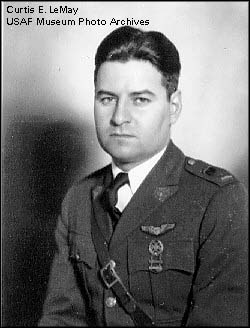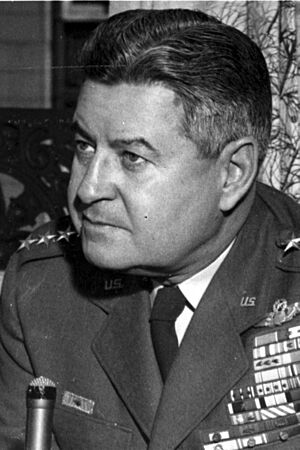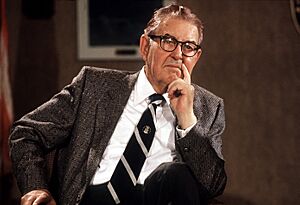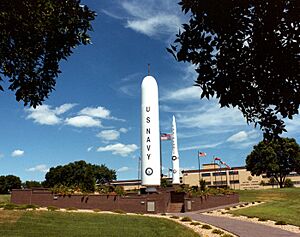Curtis LeMay facts for kids
Quick facts for kids
Curtis LeMay
|
|
|---|---|
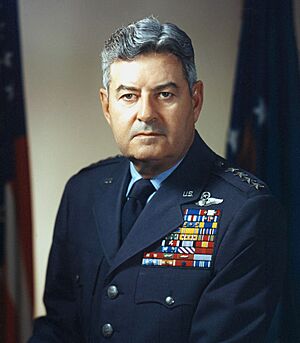
Official portrait, c. 1950s
|
|
| Nickname(s) | Old Iron Pants The Demon Bombs Away LeMay The Big Cigar |
| Born | November 15, 1906 Columbus, Ohio, U.S. |
| Died | October 1, 1990 (aged 83) March Air Force Base, California, U.S. |
| Buried |
United States Air Force Academy Cemetery
|
| Allegiance | United States |
| Service/ |
|
| Years of service | 1929–1965 |
| Rank | General |
| Commands held |
|
| Battles/wars | |
| Awards |
|
| Alma mater | Ohio State University (BS) |
| Spouse(s) |
Helen Maitland
(m. 1934) |
| Children | 1 |
| Political party | Republican |
Curtis Emerson LeMay (November 15, 1906 – October 1, 1990) was a highly influential US Air Force general. He was known for leading a powerful strategic bombing campaign during World War II in the Pacific. Later, he became the Chief of Staff of the United States Air Force from 1961 to 1965.
LeMay joined the United States Army Air Corps in 1929, which was the Air Force before it became its own branch. By the time the U.S. entered World War II in December 1941, he was a major. He commanded bomber groups in both Europe and Asia. After the war, he helped organize the Berlin Airlift and led the Strategic Air Command (SAC). He pushed for the Air Force to focus on nuclear weapons delivery. During the Cuban Missile Crisis and the Vietnam War, he suggested strong bombing actions.
After retiring in 1965, LeMay ran for Vice President in 1968 with George Wallace. They had a strong showing for a third party. LeMay passed away in 1990 at the age of 83.
Contents
Early Life and Education
Curtis LeMay was born in Columbus, Ohio, on November 15, 1906. His family moved often because his father, Erving Edwin LeMay, struggled to keep a job. His mother, Arizona Dove LeMay, worked hard to keep the family together. They eventually returned to Columbus, where Curtis went to public schools.
He graduated from Columbus South High School. He then studied civil engineering at Ohio State University. He worked his way through college and earned a bachelor's degree. While at Ohio State, he was part of the Pershing Rifles and the engineering fraternity Theta Tau.
Becoming a Pilot and Leader
LeMay became a second lieutenant in the Air Corps Reserve in October 1929. He received a full commission in the United States Army Air Corps in January 1930. He completed his flight training in Columbus in 1931–32. On June 9, 1934, he married Helen Maitland.
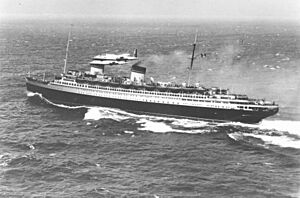
He started as a pursuit pilot. In 1937, he switched to bomber aircraft. He was one of the first Air Corps members to get special training in aerial navigation. In 1938, he helped navigate three B-17s over the Atlantic Ocean to find the Italian liner SS Rex. This showed that land-based planes could defend American coasts.
By the end of 1940, he was an operations officer at Westover Air Reserve Base. As World War II approached, he was promoted quickly. LeMay believed that constant training was vital for his crews. He often said, "You fight as you train." This meant that in combat, airmen would perform well only if their actions were second nature from practice. His troops often called him "Old Iron Pants" and "The Big Cigar."
World War II Contributions
When the U.S. entered World War II in December 1941, LeMay was a major. He commanded the 305th Bomb Group, a new B-17 Flying Fortress unit. He took this unit to England in October 1942. He led them in combat and helped develop the combat box formation, which protected bombers from enemy fighters.
In September 1943, he became the first commander of the new 3rd Air Division. He personally led dangerous missions, like the one to Regensburg, Germany, where his planes flew beyond the range of escort fighters.
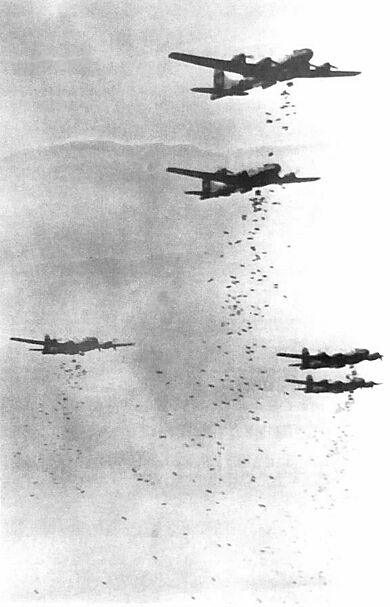
In August 1944, LeMay moved to the China-Burma-India theater. He then took charge of all strategic air operations against Japan. He realized that the bombing methods used in Europe would not work against Japan. His Boeing B-29 Superfortress bombers were not hitting targets accurately. Japanese air defenses and mechanical issues also caused many losses.
In January 1945, LeMay was put in command of the XXI Bomber Command in the Marianas. He decided that high-altitude precision bombing was not effective due to cloudy weather and strong winds over Japan. He switched to low-altitude nighttime attacks using incendiary bombs. Japanese cities were largely built of wood and paper, making them very vulnerable to fire.

LeMay led B-29 operations against Japan, including huge firebombing raids on 67 Japanese cities. This included the firebombing of Tokyo on March 9–10, 1945. This was the most destructive bombing raid of the war. For this attack, LeMay ordered the removal of defensive guns from 325 B-29s. The planes were loaded with incendiary bombs and flew at lower altitudes.
In three hours, the bombers dropped 1,665 tons of incendiary bombs. This caused massive destruction and loss of life. LeMay also oversaw Operation Starvation, which involved dropping mines in Japanese waterways. This disrupted Japanese shipping and supplies. This operation, along with a submarine blockade, greatly reduced Japan's ability to supply its forces.
LeMay believed these attacks were necessary to end the war quickly and save lives. Presidents Roosevelt and Truman supported his strategy. They estimated that invading Japan could cause one million Allied casualties.
Post-War Leadership
The Berlin Airlift
After World War II, LeMay thought about how future wars would be fought. In 1947, he became commander of USAF Europe. He helped coordinate the Berlin Airlift in 1948. The Soviet Union had blocked land routes to West Berlin, threatening to starve its people.
Under LeMay's direction, Douglas C-54 Skymaster planes began supplying the city. By late 1948, the airlift brought in 5,000 tons of supplies daily. The airlift lasted 11 months, with 213,000 flights bringing 1.7 million tons of food and fuel. The Soviet Union eventually gave up the blockade.
Leading Strategic Air Command
In 1948, LeMay returned to the U.S. to lead the Strategic Air Command (SAC). When he took over, SAC was not very strong. Many planes were not working, and crews were not well-trained. LeMay found that most bombers missed their targets by a mile or more during a practice mission. He said, "We didn't have one crew... who could do a professional job."
LeMay worked to make SAC a powerful force. He believed SAC's main job was to deliver 80% of the nation's atomic bombs in one mission if war broke out. He created the first SAC Emergency War Plan in 1949, which planned to drop 133 atomic bombs on 70 Soviet cities within 30 days.
In 1951, at age 44, LeMay became the youngest American four-star general since Ulysses S. Grant. He also served the longest in that rank in American military history. LeMay led SAC until 1957, turning it into a modern, efficient, all-jet force. He insisted on strict training and high standards for everyone in SAC.

LeMay helped SAC get many new strategic bombers and set up a huge aerial refueling system. He also developed a strong ballistic missile force. He made sure SAC had a strict command and control system and was always ready. He was known for caring about his men's well-being, encouraging activities and giving promotions for good performance. When he left, SAC had 224,000 airmen, nearly 2,000 heavy bombers, and almost 800 tanker aircraft.
Chief of Staff of the Air Force (1961–1965)
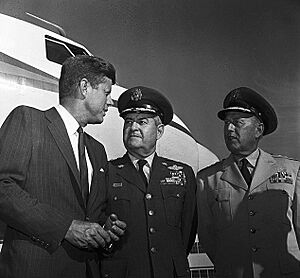
LeMay became the fifth Chief of Staff of the United States Air Force in 1961. He believed that strategic air campaigns were more effective than tactical strikes. This idea became Air Force policy during his time as chief.
During the Cuban Missile Crisis in 1962, LeMay disagreed with President John F. Kennedy and Defense Secretary Robert McNamara. He wanted to bomb nuclear missile sites in Cuba. He opposed the naval blockade. After the crisis ended, he still suggested invading Cuba. Kennedy did not agree with LeMay's requests, and the naval blockade worked.
LeMay also pushed for a strong bombing campaign against North Vietnam during the Vietnam War. He believed this would make them stop fighting. His advice was not followed, and a more limited bombing policy was used. LeMay famously said that North Vietnam should "draw in their horns and stop their aggression, or we are going to bomb them back into the Stone Age." He later clarified that he meant the U.S. had the capability to do so, not that it should be done.
After the Military
LeMay retired from the Air Force in February 1965. In the 1968 United States presidential election, he became the running mate for former Alabama Governor George Wallace on the American Independent Party ticket. The campaign received 13.5% of the popular vote and won five states. LeMay's comments about nuclear weapons caused some controversy during the campaign.
LeMay moved to Newport Beach, California, in 1969. He passed away on October 1, 1990, at March Air Force Base from heart complications. He is buried at the United States Air Force Academy Cemetery in Colorado Springs, Colorado.
Honors and Legacy
LeMay received many awards from different countries for his military service. These included the Distinguished Service Cross and the Distinguished Service Medal. He was also given the French Légion d'honneur and Japan's Order of the Rising Sun.
In 1977, LeMay was added to the International Air & Space Hall of Fame. The Air Force has an award named in his honor, the General Curtis E. LeMay Award. This award recognizes the best large Air Force support squadron.
LeMay was also an active amateur radio operator. He helped make (SSB) radio the standard for SAC bombers. He also loved sports cars and helped the Sports Car Club of America use SAC bases for races. He was inducted into the SCCA Hall of Fame in 2007.
LeMay was also important in the return of Judo after World War II. As an assistant to General Douglas MacArthur in Japan, LeMay made practicing judo a regular part of Air Force duties there. He promoted judo within the U.S. armed forces.
Images for kids
-
Major General Curtis LeMay with General of the Air Force Henry H. Arnold and Lieutenant General Barney M. Giles and Brigadier General Emmett O. Donnell.
-
General LeMay conversed with President Kennedy at the Oval Office, White House in October 1962.
Public Buildings Named After LeMay
- The headquarters building of U.S. Strategic Command at Offutt AFB in Nebraska is named the General Curtis E. LeMay Building.
- LeMay Elementary School, opened in 1968, is located in the housing area of Offutt AFB.
See also
 In Spanish: Curtis LeMay para niños
In Spanish: Curtis LeMay para niños
- List of commanders of USAFE
- Commanders-in-Chief of The Strategic Air Command


